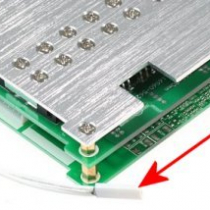Blog

FAQ: the temperature sensors at the SBM boards
FAQ: the temperature sensors at the SBM boards
Question: What is the purpose of the temperature sensor at some of the SBMs?
Answer: The temperature sensor is designed to work as an over heating protection for the MOS-FET transistors of the SBM board that regulate the power. This temperature sensor must be mounted tightly to the SBM cooling plate. For some high power applications the SBM cooling can be improved by addition external coolers or even fans. The temperature sensor needs to be mounted in the way to detect a possible overheating of the SBM board. If the sensor is not mounted, the SBM may overheat and the power transistors will be burnt. The burning of the transistors is not covered by the manufacturer’s warranty.
The temperature sensor is not designed to monitor the temperature of the battery pack. The temperature of the sensor is set to 60*C and this temperature is already too high for the LFP cells. Generally we suggest to keep the temperature of the LFP cells bellow 40*C with the 55*C being the maximal temperature limit given by many manufacturers.

 English
English Česká republika
Česká republika Germany
Germany France
France España
España Italia
Italia Sverige
Sverige Polski
Polski Nederland
Nederland










